Finding the Right Balance
Belief in being cursed or being subject to magical attack, can become a curse in of itself – especially when you’re already encountering a run of bad luck. So it’s important to have the proper perspective when it comes to the subject of  magical attack. Because if you place too much belief in the possibility of being cursed or attacked, then it’s all too easy to see malefic magic and psychic attack at every turn and become paranoid. There’s also a lot to be said for self-fulfilling prophecy here – especially with the more magically-minded. But if you refuse to even consider the possibility, then you run the risk of missing some of the earlier warnings and allowing things to become far worse.
magical attack. Because if you place too much belief in the possibility of being cursed or attacked, then it’s all too easy to see malefic magic and psychic attack at every turn and become paranoid. There’s also a lot to be said for self-fulfilling prophecy here – especially with the more magically-minded. But if you refuse to even consider the possibility, then you run the risk of missing some of the earlier warnings and allowing things to become far worse.
I’ve been that person in the second category, and I’m coming to you from the future to warn you about that very thing.
I messed up a lot in my early 20s with this, and a whole lot more. So trust me when I say that if you write everything off as being “just a run of bad luck”, then things can get really bad and in really unbelievable ways too.
So how do you find the right balance with this?
In truth, unless you have physical evidence that someone is working against you, you need to be looking at multiple factors. But what are they?
Luck
The most obvious thing that is going make you suspect attack is a run of bad luck that just doesn’t seem to end. But sometimes shit just happens! So how do you figure out if it’s regular old run-of-the-mill shit, or magical shit?
 This is where it gets pretty tricky, and also why you shouldn’t just rely on one thing when assessing whether or not you’ve been cursed. However, a good starting question to ask yourself is if what is happening is logical given the surrounding causes and conditions. For example, if you happen to lose your job and your house is foreclosed on during a time of economic downturn, it’s easy to see the circumstances at the root of your situation.
This is where it gets pretty tricky, and also why you shouldn’t just rely on one thing when assessing whether or not you’ve been cursed. However, a good starting question to ask yourself is if what is happening is logical given the surrounding causes and conditions. For example, if you happen to lose your job and your house is foreclosed on during a time of economic downturn, it’s easy to see the circumstances at the root of your situation.
However, if (for example) you find yourself applying for a college hardship fund and being rejected for being “too poor” after a run of being told you’re overqualified for student jobs you’ve applied for as a student, then something is probably going on. (It was. Those were some “fun” times.)
See what I meant when I said “unbelievable”?
Dreams
For a lot of people, dreams are just randomness bundled up with a combination of wish-fulfilment and stress. However, for magical practitioners dreams are a hell of a lot more. That’s not to say that we don’t also get the stress dreams about being late for French Literature class at college (or…you know…). But for us, dream can often also turn out to be a place of entrance into the Otherworld, or a common ground upon which we may interact with Otherworldly beings.
And other practitioners…
See the problem?
So if you’re not keeping an eye on your dreams, especially around the 15th lunar day, you’re missing out on one of the biggest canary warnings you could possibly have. Dreams on this day that include arrows, snakes, or any form of attack really, can be indicative that someone is working against you. Moreover, it’s often possible to divine the person (when a human is doing the cursing, but that’s another story) attacking you, and what their beef is (beyond simple ego).
For example, you may find that the attacks in your dreams are conditional on you avoiding or carrying out a certain behavior. For example, if someone wants to keep you in what they see as ‘your place’, then the attacks in the dream may only happen when you disobey instructions to not cross a boundary.
So pay attention to your dreams!
Feelings and Foreign Thoughts
Strange emotions and thoughts can come from any number of sources, especially if you’re empathic in any way (and if you are, you might want to check out this post for some handy tools). Moreover, our brains can be pretty weird places just in general. Which can make it quite difficult to figure out if a new crop of negative emotions and strange thoughts are from you, picked up  by accident from others, or the result of a curse directed at you.
by accident from others, or the result of a curse directed at you.
But what do I mean when I say “negative feelings” here? Generally speaking, the kind of negative feelings that come with an attack are an impending sense of doom and dread, and a nose dive in self-esteem. Depression is also common, as is a feeling of helplessness.
And I know, I know. Who hasn’t felt those things? I mean, for goodness sake, we live in the monstrous shitshow that is 2019!
However, when you take the time to examine why you normally have those feelings, you can usually point to concrete reasons why. Maybe it’s all the plastic in the sea? The climate crisis that is going largely ignored? The internment of asylum seekers and attendant human rights abuses? Or maybe it’s just down to the simple yet highly stressful economic insecurity that most of us experience on the regular?
The point though, is that when you get down to it, when you take the time to examine these feelings, you generally find causes that are usually highly logical (and not the result of outrageously abnormal examples of bad luck).
This is part of why meditation is important – because it gives you the tools to carry out that kind of introspective examination.
But most importantly, meditation helps you get to know your own mind. This is incredibly important when you’re subject to this kind of attack. After all, how else will you recognize which thoughts are truly yours, and which belong to a hostile party? However, for all the danger of implanted thoughts (especially the kind that ensnare the mind and have you picking out a death day on autopilot), this is also often the area where a lot of attackers ‘overplay’ their hands and give themselves away.
As the old adage says, “know thyself”.
Health
In the Old English sources, the concepts of ‘health’ and ‘luck’ (as well as wholeness and holiness) are expressed by the same word – ‘hælu’. This collocation of concepts into a singular term tends to make great sense to anyone who has worked extensively with either the paranormal, Good Folk, curses, or all of the above. Because it’s never just luck that tanks, but personal health too. For some of the more metaphysical (and scholarly) reasons for this, you can check out this essay here.
However, for the TL;DR version, let me just say that both curses and interference from the Other have very similar effects on the body, and especially the torso. So keep an eye out for gastric and other torso-related issues that are accompanied by a loss of physical energy – especially if medical investigation leads nowhere.
Dying Plants and Eggs
Finally, a lot of witches look to their plants. If a lot of your plants suddenly start  dying off, then there’s a chance that someone is working against you. This is especially the case when this happens in conjunction with any of the other factors mentioned here. Some folks also keep an egg on their altar as a kind of hex alarm and watch for it breaking. Of course, you may go through quite a few eggs, and will need to remember to change them out if you opt to do this.
dying off, then there’s a chance that someone is working against you. This is especially the case when this happens in conjunction with any of the other factors mentioned here. Some folks also keep an egg on their altar as a kind of hex alarm and watch for it breaking. Of course, you may go through quite a few eggs, and will need to remember to change them out if you opt to do this.
Being Off-Balance
Find yourself taking more trips and falls recently? Perhaps you’re experiencing the kind of clumsiness that you only normally get before your period (if you have those), but at the wrong time?
It’s not uncommon for people to experience more falls and injuries when subjected to psychic attack – part of this is down to that luck thing.
But in my opinion, there’s also a wider theme of keeping you off balance here too. This is something you may also see reflected in your thoughts. You may find yourself fixating on something or someone completely random and illogical – just out of the blue, to the point where it’s taking over everything to a really unhealthy degree. And it’s smart too – part of keeping you otherwise occupied so you can’t do the things you need to to fight back.
Now I’m not saying that every weird crush or obsession with a thing or person is the result of magical attack (especially if you’re already predisposed to obsessive behaviors). But it’s another factor to take into account along with everything else.
Next Steps
So what do you do if you suspect that you have been hexed by another practitioner (or even the Other)?
Your first next step is to perform divination and find out if your suspicions are reflected in a reading. Depending on what’s been done to you though, you may find yourself unable to read for yourself (assuming you could do it before), and in these cases you will need to get a reading done by someone else. Honestly though, regardless of whether or not you can read for yourself, it’s advisable to get a reading done by a trustworthy person anyway. In my experience, the role of divination in the diagnosis and management of malefic attacks is one that is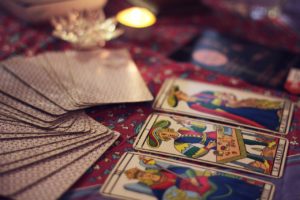 often forgotten. And I get it, it’s easy to lose your head when you suspect that magic is being thrown around – especially if you’re already a little battle-scarred before figuring out what’s going on. However, if someone is working against you and you give into that fear, you help them in their cause.
often forgotten. And I get it, it’s easy to lose your head when you suspect that magic is being thrown around – especially if you’re already a little battle-scarred before figuring out what’s going on. However, if someone is working against you and you give into that fear, you help them in their cause.
Divination can provide a chance to catch your breath and at least run your thoughts by another human. This is important for two reasons: firstly, running it by another person can provide a valuable “checksum” that you’re not experiencing some kind of mental breakdown; and these kind of experiences tend to be pretty isolating (which is never good when you’re vulnerable). Most importantly (?) though, divination can help you take stock of the situation, and may sometimes even give you information on how best you can defend yourself or otherwise end the attack. In other words, it’s a critical first step on the path to resolution and healing.


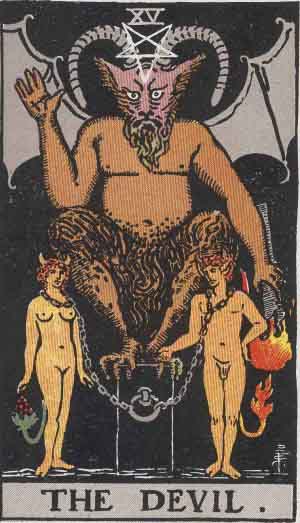

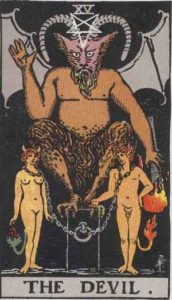 or they sort of ferment over time. In my experience of these slow wars, you usually have about 2-3 years of fermentation punctuated by relatively minor periods of being poked at before hostilities fully escalate.
or they sort of ferment over time. In my experience of these slow wars, you usually have about 2-3 years of fermentation punctuated by relatively minor periods of being poked at before hostilities fully escalate. of the heavy-lifting here, so these are the relationships you really need to cultivate.
of the heavy-lifting here, so these are the relationships you really need to cultivate. You see, sometimes witch wars involve sending asshole spirits to mess with you, and those asshole spirits tend to gravitate to the shitty, cluttered areas of your home like mosquitoes do to buckets of water. (This is pretty much why paranormal teams get people to clean up as part of the solution.)
You see, sometimes witch wars involve sending asshole spirits to mess with you, and those asshole spirits tend to gravitate to the shitty, cluttered areas of your home like mosquitoes do to buckets of water. (This is pretty much why paranormal teams get people to clean up as part of the solution.) starts the war.
starts the war. these things, gains the keys to the kingdom. There is so much more that they can do to you with this stuff- trust me on this. Because there was this one fun time and it literally nearly fucking killed me.
these things, gains the keys to the kingdom. There is so much more that they can do to you with this stuff- trust me on this. Because there was this one fun time and it literally nearly fucking killed me.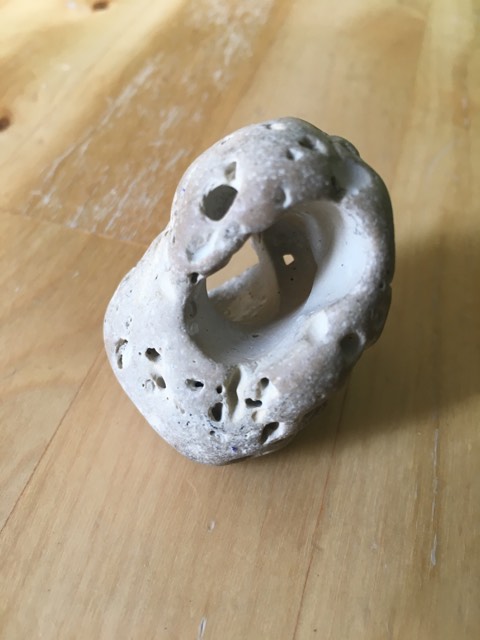

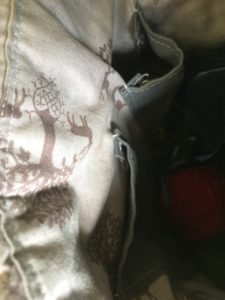
 middle of them, and although I haven’t really found good scholarship on them, my experience has been that these are both effective tools and apotropaics. They’re protective against the Unseen, and allow you – again, in my experience – to see through glamours and things that are normally unseen if you look through them.
middle of them, and although I haven’t really found good scholarship on them, my experience has been that these are both effective tools and apotropaics. They’re protective against the Unseen, and allow you – again, in my experience – to see through glamours and things that are normally unseen if you look through them.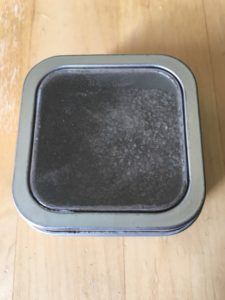 general because it has so many uses. You can use it to salt boundaries, protect, and banish. But black salt is just taking regular old salt and leveling it the fuck up! The addition of iron, ash, and (in my case) ground wolf bone, makes black salt an excellent addition to a go-bag. It’s like an apotropaic powerhouse!
general because it has so many uses. You can use it to salt boundaries, protect, and banish. But black salt is just taking regular old salt and leveling it the fuck up! The addition of iron, ash, and (in my case) ground wolf bone, makes black salt an excellent addition to a go-bag. It’s like an apotropaic powerhouse! energy that might “grow up” to get its own ideas and start its own trouble. Spun fiber can provide a bridge, delineate space, and serve as an offering in its own right. I have two spindles that I typically use in ritual work: one is a collapsible spindle that fits in my bag; and the other,
energy that might “grow up” to get its own ideas and start its own trouble. Spun fiber can provide a bridge, delineate space, and serve as an offering in its own right. I have two spindles that I typically use in ritual work: one is a collapsible spindle that fits in my bag; and the other, 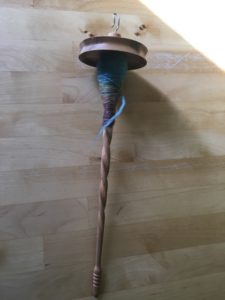 my large one, was a gift to thank me for help given. I adore my large one because it feels weighty and authoritative – like a wand. It’s something I’ve wielded in ritual before now when opening portals and working my will. The collapsible one lives in my purse (yes, it’s that small) along with the sheep knuckle I use for yes/no divination.
my large one, was a gift to thank me for help given. I adore my large one because it feels weighty and authoritative – like a wand. It’s something I’ve wielded in ritual before now when opening portals and working my will. The collapsible one lives in my purse (yes, it’s that small) along with the sheep knuckle I use for yes/no divination.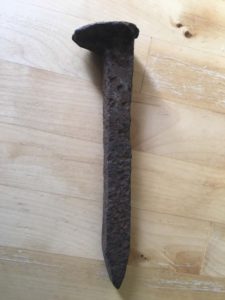 resonance to this item that just works. I’ve engraved it with words of power (which I won’t show here), and it’s one of my favorite spirit weapons for subduing, setting up some hardcore protective space, or for when things go bad. I don’t know whether it’s wholly iron or steel (which is mostly iron anyway), but it’s kickass anyway.
resonance to this item that just works. I’ve engraved it with words of power (which I won’t show here), and it’s one of my favorite spirit weapons for subduing, setting up some hardcore protective space, or for when things go bad. I don’t know whether it’s wholly iron or steel (which is mostly iron anyway), but it’s kickass anyway. This is one of my more McGyver-type items. Red thread can be used to bind and protect, or create new items (like a crossroads effigy or protective rowan cross). It can also be used for knot spells, marking off space, and much more. The yarn I use is hand spun with intent and then ritually consecrated.
This is one of my more McGyver-type items. Red thread can be used to bind and protect, or create new items (like a crossroads effigy or protective rowan cross). It can also be used for knot spells, marking off space, and much more. The yarn I use is hand spun with intent and then ritually consecrated.


 entice you into some kind of oath, your first move is always research. Go find out everything you can about them, and if it’s not available in physical sources, go pester allies for more information. Because there are a whole bunch of things you need to know here. For example, you need to know their MO; if they’re presenting themselves as they actually are; how others have fared dealing with them; and if they have a GSOH and enjoy long walks on the beach at sunset. Because all of that will not only help you figure out *who* you’re dealing with, but also help you better word any oaths you make so that you can do stuff like insert more protective clauses (which is #winning, trust me).
entice you into some kind of oath, your first move is always research. Go find out everything you can about them, and if it’s not available in physical sources, go pester allies for more information. Because there are a whole bunch of things you need to know here. For example, you need to know their MO; if they’re presenting themselves as they actually are; how others have fared dealing with them; and if they have a GSOH and enjoy long walks on the beach at sunset. Because all of that will not only help you figure out *who* you’re dealing with, but also help you better word any oaths you make so that you can do stuff like insert more protective clauses (which is #winning, trust me).

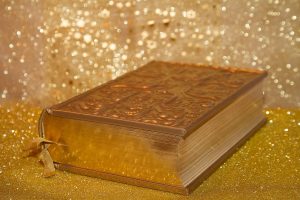

 accordingly, as I do respect her). I do think she makes an excellent point about the duotheisms held dear by the earlier Pagan revivalists, and their incompatibility with both modern and ancient ideas on deity. But does that mean that we should once more throw out yet another baby with the water it was bathing in? (Which per
accordingly, as I do respect her). I do think she makes an excellent point about the duotheisms held dear by the earlier Pagan revivalists, and their incompatibility with both modern and ancient ideas on deity. But does that mean that we should once more throw out yet another baby with the water it was bathing in? (Which per  I shall go into a hare,
I shall go into a hare,

 respective worlds, our little treasures who never tire us or make us angry; friends of mine refer to this as ‘the cult of the child’. However, regardless of how much we love our children, we all *need* time to replenish ourselves, to do things that recharge the batteries we draw so deeply upon when dealing with the fifteenth tantrum of the day, or the horror of heavy-handed black crayon on carpet. Like the analogy of the parent putting their oxygen mask on before that of the child, if we don’t take care of ourselves, we can’t take care of them to the fullest of our abilities.
respective worlds, our little treasures who never tire us or make us angry; friends of mine refer to this as ‘the cult of the child’. However, regardless of how much we love our children, we all *need* time to replenish ourselves, to do things that recharge the batteries we draw so deeply upon when dealing with the fifteenth tantrum of the day, or the horror of heavy-handed black crayon on carpet. Like the analogy of the parent putting their oxygen mask on before that of the child, if we don’t take care of ourselves, we can’t take care of them to the fullest of our abilities.


 Everything feels so alive, there’s a buzz in the air, a rightness of place, and not for the first time I think to myself that this is what it must be like to put down roots somewhere.
Everything feels so alive, there’s a buzz in the air, a rightness of place, and not for the first time I think to myself that this is what it must be like to put down roots somewhere. moment you walk the boundaries with fire to take your land, you’re granted an agency in that place that you don’t have as a traveler. In your home, you get to create your cosmos, your inner-yard, your most holy of spaces instead of moving between the inner-yards of others and dodging the dangers of the outer-yard. You build reciprocal relationships with the wights in a way that you never did before, like the kind that neighbors make with neighbors who bought as opposed to those who rent. Wandering, liminal gods are joined by gods of ‘peace and good seasons’ in your hearth rites; and the magic you work is less because some scary ‘could kill you’ shit is going down, and more because your family needs a little extra help at times to continue thriving, or even simply just to keep your hand in.
moment you walk the boundaries with fire to take your land, you’re granted an agency in that place that you don’t have as a traveler. In your home, you get to create your cosmos, your inner-yard, your most holy of spaces instead of moving between the inner-yards of others and dodging the dangers of the outer-yard. You build reciprocal relationships with the wights in a way that you never did before, like the kind that neighbors make with neighbors who bought as opposed to those who rent. Wandering, liminal gods are joined by gods of ‘peace and good seasons’ in your hearth rites; and the magic you work is less because some scary ‘could kill you’ shit is going down, and more because your family needs a little extra help at times to continue thriving, or even simply just to keep your hand in.




